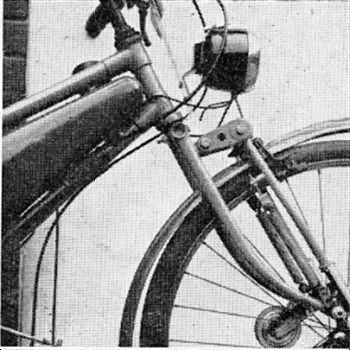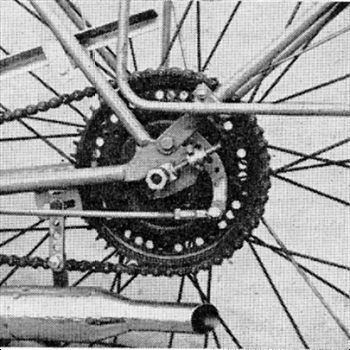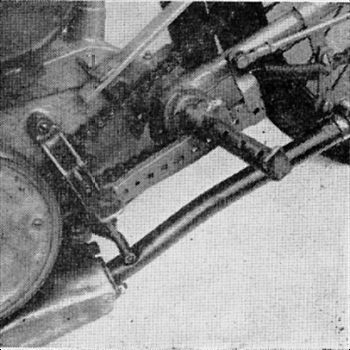 Go
to the Archive index
Go
to the Archive index"One of these days, I'll do her up and ride her again." The mechanic at the local garage shrugged his shoulders and dived beneath a three ton lorry, armed with spanners and such like. "Seems a pity", said I to the protruding feet, "that it just has to rot away and gather the cobweb". "Had a new piston and crank assembly last year it did too", said the prone mechanic from the region of the lorry's rear axle.
I wandered off. Six months later I again brought up the subject of the derelict New Hudson autocycle. "Getting a bit rusty" I said cheerfully, (and hopefully). "Thinking of doing it up and riding it again", said the mechanic with what I thought was slightly less enthusiasm than when I had broached the topic earlier. My view was that good engine or not, the general apparent debility was sufficient to induce me to make a very low offer to him, and gentle prods over a further period of six months or more would either goad the owner into "doing it up", or selling it to me for a song if for no other reason than to get rid of me. I didn't mind waiting, and in the end I took the thing away, wheeling it on the front wheel in one trip, and carrying the back wheel away on the next. I paid three pounds for the load of rust and cobwebs that once had been a smart and nippy autocycle.
Next evening, I tore into this lot with a frenzy, more to satisfy the family who regarded my purchase with the most obvious distaste. Off came the handlebars, front forks, saddle, mudguards and what was left of the wiring - like drawing the insides out of a chicken, the rubber insulation was all perished and horribly sticky. The contents of the petrol tank smelt like varnish, and I removed the tank and stowed it out of doors and hoped that the rain would help in removing the pong. It never did rain, but later I swilled the thing out with methylated spirits which seemed to clear the air well enough. I removed the great big pedals that one is supposed to start these bicycles with, and threw them into the dustbin. I figured that if I couldn't start a 98cc engine with a gentle ground push, then I must be older and more senile than my birth certificate shows. Into the dustbin went the front wheel and forks, not really because they were so bad as to be unrestorable, but more because they weighed a ton combined, and I was aiming at transferring my Raleigh pedal cycle forks fitted with Telelink springing attachment, very much more supple, and considerably lighter. I had had a new wheel in the Raleigh not so long ago, all nice and shiny, and that was a further inducement to reject the original front assembly.

The "Telelink" attachment added to the standard Raleigh forks
The rear wheel didn't need any removal, it had been out for over two years, and lacked the trivial detail of wheel nuts anyway. Being a credulous sort of person, I left the engine in the frame, after all, it had recently been overhauled I had been told, so theoretically should require no major attention.
As things turned out, this piece of credulity on my part was fully justified, the sole requirement being a thundering good decarbonising. I was lucky.
With the frame propped up on the bench, and resting on the boxy silencer, I got weaving with my "wet and dry" abrasive paper, and rubbed down the frame so that an even matt finish resulted. The many and several rusty patches were rubbed at with more enthusiasm, then doused with hot Jenolite to kill the rust. (Jenolite must be the overhauler's best friend, it is first class.) I rubbed down my Raleigh forks, and the mudguard stays, and washed off with cold water, afterwards drying with a cloth, and leaving for 48 hours. My choice of colour scheme was simply solved.
I had a large can of "Agricultural Implement gloss paint - Ferguson Grey". I also had by me a small tin of cherry red, and no intention whatsoever on spending any more money on the job than I had to, so the grey went on to the frame and forks, and the tank was done in cherry red, together with the rear mudguard, and the "Slim Jim" front mudguard off the Raleigh. I gave it two coats of paint, well brushed, with a week in between coats.
A rub down with some car polish brought up the finish to a standard I considered entirely adequate - if not perhaps quite Earls Court.
These old autocycles are low geared. They had to be, as there was only one gear anyway, and this same gear had to be suitable for all types of going. I live in a flat area, where a higher gear would clearly he desirable, and what with the weight reductions I had in mind, allied to the lack of hills in the locality, decided me in favour of raising the gear ratio. I found out that an engine sprocket of 11 teeth was made for these Villiers Junior engines, to replace the 10 tooth sprocket. Whilst not a very impressive alteration, this seemed to he a good idea, and I obtained one at a cycle shop that knew quite a bit about old New Hudsons. "You'll have trouble fitting it though" said the proprietor of the shop, "The boss is longer, and the chain will foul the flywheel". He was dead right, I had to grind away the boss on the eleven-toother, and the links of the chain just went "chunk chunk" on the flywheel rim. I removed the flywheel, awarding a metaphoric slap on the back to Mr Villiers for incorporating a self-drawing nut on the taper of the mainshaft. You just put a spanner on the nut, and wind off the flywheel, no special tools, no nothing. I took the flywheel round to my local garage, and they took 3/16" off the diameter, for a distance of 3/8" to overcome that little problem.
The rear wheel had a splendid rim, and a fully serviceable brake, but some of the spokes were on overtime, because a number of their fellows had succumbed years ago.
My cycle dealer put me in new spokes where required, and sold me a pair of wheel nuts and a pair of bearing cones. The linings in the brake must have been renewed by an earlier owner, they were near perfect. Lucky again. One of the accompanying photos shows the drillings I put in the flange of the sprocket. This pleased my ego very considerably more than it lightened the flange, and puts me in good company with the latest "coffee bar racers". I looked with suspicion at the lack of means for preventing water from entering the brake, so accepting things as they are, I drilled four 3/32" diameter holes right in the comer of the brake drum, to allow the inevitable water seepage into the drum to be flung out by centrifugal force.

The extra silencer and the rear sprocket drilled "to please my ego"
I took the ball tracks off the Raleigh frame and put these in the steering head of the Hudson and fitted the forks. In went my modified rear wheel, sporting a new tyre, but still keeping the old tube which surprisingly enough had only one patch on it. The cycle flat type narrow handlebars looked much better than the original district nurse bends, but rear brake operation could no longer be by hand.
"Good show" said I, it immediately indicated a foot pedal brake operation, just like a motorbike. So I made up from steel tube a straight footrest, passing through the old pedalling bottom bracket, and the original ball cups and nuts are used to lock the tube up solid against brazed on washers. I made the brake pedal from ordinary angle iron, cut down on one flange, and more holes went in to add to the rapidly growing air of sportiness. From the car graveyard I found a pair of Ford brake clevis joints, and these I put into service to couple the pedal to the rear brake arm. A strip of aluminium folded to right angles gave me a TT type rear chain guard.

The simple footrest assembly and rear brake pedal
I fitted the petrol tank, put a new chain on, and pushed the half completed model off. A woolly spluttering and clouds of blue smoke, and a complete lack of power. Back in the garage, I tore off the silencer and looked at the coke inside. The exhaust port was almost completely bridged over with carbon, so I gave the full decoke treatment. I added an extension tube to the box silencer, then a small chrome plated silencer I had had kicking about for years. My views on noise may be at variance with some people's, I just figure that the quieter you are, the faster you can go without anybody noticing.
I rewired the lights, and tidied up all the rest of the job. The first few miles showed up a snag, the engine sprocket nut worked loose, and to put an end to this bother, I drilled and tapped 2BA holes in the wall of the nut and screwed in a couple of short Allen screws, to lock the nut on the thread.
So for my fiver, I have a perfectly reliable and handy little No-Ped, capable of 36mph and a fuel consumption of 150mpg. Steering and roadholding are perfect, perhaps the longish wheel base helps here, and the caliper front brake (the car world is all excited about disc brakes which are really nothing more than side pull caliper brakes) combined with the hub rear gives a nicely balanced braking, quite in keeping with the modest performance. Have I missed the pedals?
Not yet, and the steepest hill I can find has only made the little engine slow down to a steady purr.
First published in Power & Pedal, December 1959